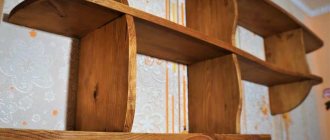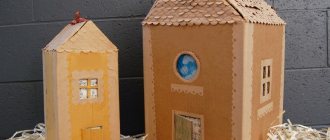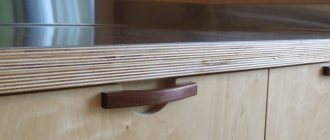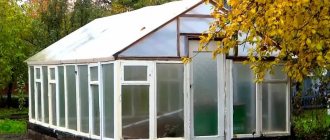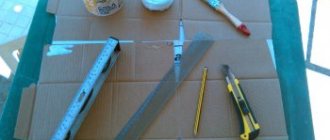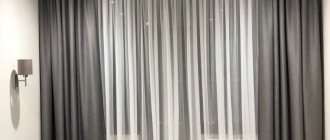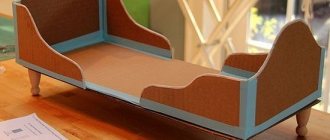Types of screens
Modern screens come in several types depending on the structure, purpose and materials used. When choosing a design option, you need to take into account the stylistic direction and the place in which the product will be located. Main varieties by functionality:
- Casement (sliding). Until recently, screens were the only options. The product has a rigid frame on which fabric, paper or other material is stretched, and includes several frames connected to each other - 3–8 or more. If necessary, they are folded like an accordion and removed. Initially, the frame was made of wood, but later it was replaced with lighter aluminum.
- Single screen. They include only one wide sash - it can be a frame made of any material with fabric or paper stretched over it, or a sheet of plastic, plywood, chipboard or glass mounted on a stand. It is recommended to equip this option with wheels.
- Screen-book. Consists of a pair of leaves of the same or different widths. When it’s time to move it to another place, the product easily folds into a book. This type of product can be used for holiday photo shoots or simply for dressing up.
- Flexible. For their manufacture, long thin sections (pipes, plates, slats) are used, which are connected to each other. The structure is a single wall. The peculiarity of flexible products is that they can be placed in a spiral, a wave, or even rolled into a roll and put aside.
- Deaf. They consist of a different number of valves, but their peculiarity is complete opacity. For production, a solid board can be used (a screen made of plywood, chipboard, etc. is popular), thick fabric stretched over a frame, or cardboard inserted into the frame.
- Transparent. They are often a transparent material stretched over a frame, such as tulle, organza or even starched gauze. No less in demand are metal versions made using the air forging technique, or wooden models with through openwork carvings.
Materials
When you decide to make a screen with your own hands, first decide on the appropriate material. Traditionally, a product of this type was made of wood - slats or solid boards. Today, creativity and originality are valued, so a variety of materials are used to make partitions. Common options:
- Tree. A simple smooth board or material with a pattern cut out on it, or a structure made of slats or beams will do. Plywood is easy to process, light and inexpensive. You can even build a partition from old doors, after first restoring their panels and giving them a fresh look.
- Plastic. Pipes made of this material are widely used, which are suitable for creating frames or frames. They are cheaper than metal ones and weigh less. The product made from plastic pipes is easy to assemble and disassemble. They are easy to care for: you just need to periodically brush off the dust from their surface. An alternative is plastic panels; it is very easy to make a partition from them. You can select several panels that have the same pattern and connect them to each other. The finished partition is well suited for a bathroom, swimming pool or garden shower.
- Metal. Metal frames of a given shape are often used, which can be ordered from a specialist. Panels made of plastic, glass, wood are inserted into them, or fabric is stretched. Iron sheets look bulky and do not make the room cozy, but an ornament forged from twigs will give the partition a spectacular look. Often, metal pipes with a diameter of no more than 5 cm are used to create a frame. A screen of this type will decorate a garden or yard.
- Cardboard. Cheap and affordable material from which you can make a creative, original screen with your own hands. It is very easy to work with it, because... you just need to cut out the parts in accordance with the diagram and fasten them into one sheet. Ready-made partitions are not suitable for the street, because... they will quickly deteriorate under the influence of weather factors.
- Branches. This includes reed, willow, and bamboo. Screens made from them are mobile, light and visually simple. They go well with various interior styles: tropical, classic, empire, eco-style. Their production requires the performer to have wicker weaving skills. The finished product will look great in the garden and will not deteriorate from wind, rain and sun if the material is processed correctly.
- CDs and vinyl records. These parts are connected to each other using staples or threads. The result is an original openwork canvas that can be hung anywhere in the room in the form of a wave, a semicircle or in a straight line.
Design and installation
A drawing of one leaf (section) of a simple screen is given in pos. 1 pic below. It is better to make the legs of an outdoor screen (for example, a country screen for a summer shower on the wall) asymmetrical in height (item 2), so the door leaf will get less dirty.
A screen-partition for a room, on the contrary, will be more convenient with symmetrical shortened legs of a smaller supporting area, pos. 3:
- Shortened legs will reduce the visibility of the space behind the screen.
- A reduced support area will increase the stability of the screen, see below.
- The vertical symmetry of the legs will allow you to install the screen in the position you need, without looking closely at where the top is and where the bottom is and without turning it over. In a small room cluttered with furniture, this can be quite significant.
It is better to use anti-slip furniture pads on the legs of a heavy wooden screen, pos. 4. Wheels and rollers are under no circumstances suitable: even a lightly overturned screen can cause trouble. Least dangerous for fragile objects near the EPS screen, see below.
Note:
You shouldn’t make a screen without legs - it will rub the floor, get very dirty, and in the summer it will be stuffy behind it.
Sustainability
The folding screen loses stability when the opening angle of the doors is more than 150 degrees. For the safety of vases and cups, the opening angle is limited to 135 degrees; This also makes it possible to expand the screen into the shower stall, because The angle on the reverse side will be 90 degrees. The simplest screen opening angle limiters are made from laces or nylon threads, see fig. If the screen will be folded and put away for storage, the limiters on one side are made to be detachable with buttons or clothing snaps.
DIY fabric screen with wooden frame
The classic version is a fabric screen stretched over a wooden frame. The product is made in the form of a dressing table, book or accordion. The number of frames affects the final shape. Prepare the following tools and materials:
- drill, screwdriver;
- construction stepper;
- hacksaw, sandpaper;
- door hinges (12), screws (96);
- textile;
- wooden blocks (24);
- varnish, paint, universal glue;
- decorative elements (beads, ribbons, etc.).
It is recommended to take the bars 2 cm thick and 6 cm wide. In this case, one half should have a length of 170 cm, and the other 60 cm. Stages:
- Measure 6 cm from the edge of each plank and draw a line. Then make cuts along the markings up to half the width of the planks.
- Make cuts from each edge of the plank by removing a layer of wood to the notch - place a chisel on the beam and hit it with a hammer. Apply universal glue to the inner surface and assemble the slats into the frame, then press them tightly.
- After the glue has dried, sand the surfaces with sandpaper and coat with wood varnish. Secure the door hinges to the frame with a screwdriver.
- The finished base for the screen should be decorated with fabric of any texture and color. Make a pattern according to the dimensions of the frame, taking into account the hems. Use a staple gun to attach the fabric to the base. The tension should be good. Start fastening in the following order: top, bottom and sides.
- Next, start assembling the screen for the door hinges. The latter will need 2 per 1 connection to make folding the product convenient in the future.
DIY room screen made of cardboard
One interesting option is a cardboard screen. To make it yourself, order cardboard tubes designed for winding fabrics or linoleum. In a specialized store they are generally considered waste. The finished partition will have a wavy shape. Set of tools and materials:
- cardboard tubes (16–20);
- strong decorative rope (1 skein);
- drill;
- scissors, tape measure, pencil;
- paint of a color suitable for the interior (optional).
If you decide to use pipes for linoleum, then 8–10 pieces will be enough. Their length is more than 3 m, so cut each one in half:
- Cut all the pipes to the required height and lay them out in a row.
- Measure 20 cm from the bottom edge and make a mark on each element (point A).
- Measure upward a segment 1 m long and make a new mark (point B).
- Next, mark point C in the center of each pipe. Drill holes in the marked places.
- Thread the decorative rope: first at points A, then B and C. After this, move the pipes and tie strong rope knots on the sides of the screen. The result will be a screen similar to a reed or bamboo partition.
What it is
A screen can be called a structure containing various hidden elements. With its help, you can organize skits, performances, use it for a puppet theater, conduct a master class in a kindergarten, and much more.
Handles rails for furniture: sizes, installation options, photos in the interior
In addition to its entertainment function, a screen or decorative fence is actively used for the development, education and upbringing of children. Believe me, any teacher in the kindergarten will only be glad if something similar appears at her disposal. These are truly multifunctional products that, with imagination and experience, can be used for a huge and varied range of applications. Using medical-themed covers, you can organize a lesson on taking care of your health. By stretching thematic canvases, it is easy to stage different performances or stage a whole performance.
Officially, such screens are called nothing less than a developing subject-spatial environment. There is even a state educational standard that it must meet.
Don’t worry, if you have ordinary polypropylene, verified dimensions and the right tools, it will be difficult to violate these standards.
But it is still important to remember that we are talking about a product for children, not adults. Leaving the kids alone near the screen, the teacher or parents should have no reason or reason to worry about their safety
All this is spelled out in the requirements and standards. In relation to the screen they are:
- Safety. We are talking about the stability of the structure and its strength;
- Transformability. The ability of the screen to change its appearance through simple movements;
- Availability. This is not about price, but about the ability of each child to carry out certain actions;
- Variability. That is, the ability to change covers and contents;
- Content and richness. Here, I think, everything is clear;
- Multifunctionality. In fact, a combination of all the previous points.
Such a decorative partition has excellent developmental functions, it allows you to concentrate and hold the attention of children, develop their intelligence, thinking, show ingenuity, learn something new, develop creatively, etc. A screen also becomes an excellent way to zone a room when conducting quizzes, skits, various kinds of events, so that children are not distracted by other things
A screen also becomes an excellent way to zone a room during quizzes, skits, and various events so that children are not distracted by other matters.
DIY decorative screen made from plastic pipes
Making a mobile screen with your own hands is possible using plastic pipes. A ready-made partition will help zone rooms or provide shelter from the sun’s rays on a hot day. Prepare:
- screwdriver;
- self-tapping screws, nuts and washers;
- paints, brush;
- furniture wheels (4);
- a board that will be the base;
- a pair of flanges;
- plastic pipes (3);
- metal pipe to weight the base.
If necessary, plastic pipes can be replaced with metal products of similar width and length. Sequencing:
- Make markings on the board. Mark the places where the wheels will be attached.
- Secure the wheels to the board using self-tapping screws.
- Fix a weighting agent (metal pipe) on the bottom side of the base. Screw it on with a self-tapping screw and using holders.
- On the upper side of the base you will need to secure the flanges into which the pipes must be inserted.
- On top of one horizontal pipe, connect two vertical ones by inserting their ends into the connecting elbows.
- After finishing the work, paint the entire structure.
- Show your imagination, for example, hang thick fabric on the frame. An old curtain will do just fine, the main thing is that its size matches the width of the frame, and the pattern with the flower matches the main notes of the interior.
- How to lose weight after the holidays
- What to do to lose weight on your arms and shoulders
- Avocado anti-wrinkle mask
Once again about loops
Screens are extremely rarely stationary. Any of them will someday have to be folded like an accordion and sent for storage. And in order for the screen to fold into a compact object, it must be equipped with hinges, placing them alternately on one side of the doors and on the other.
To ensure the rigidity of the sash, the top hinges are installed above the crossbar closest to them. And the lower ones are below the crossbar that is closest to them.
If the screen is arranged like a “booth”, you will have to remove the bevels at an angle of 40-45° from the back side of the hinges at the ends of the sashes. And if the structure will not be expanded, the ends of the outer sashes should be left straight or rounded.
Wooden changing screen
If you want to create a screen with your own hands for changing clothes, make the body from wide and thin boards of any type of wood. This design can even muffle sounds. It's easier to use MDF panels. The list of necessary tools and materials consists of:
- screwdriver, construction gun, scissors;
- primer or sealant;
- decorative construction nails;
- hinges for doors, upholstery tape;
- acrylic paint;
- 3 thin boards 45x180 cm;
- 3 pieces of padding polyester 50x200 cm;
- 3 pieces of thick fabric – 50x200 cm.
First, prepare the boards by covering one surface with primer (it will be the back part). Once the primer has dried, cover this side with acrylic paint. The following actions:
- Cut a strip of padding polyester slightly wider than the panel. Place on the board and secure with a construction gun. Cut off excess material on the sides.
- The piece of fabric should be the same size as the padding polyester. Attach it to the panel, stretch it, fold the edges and secure it over the padding polyester layer.
- Use glue to secure the upholstery tape around the edges. Additionally, secure it with nails. Repeat similar steps on all panels.
- Connect the structure by placing the two panels face down. Place furniture hinges at a distance of 10 cm from the top and bottom edges and attach them. At the end, fix the third panel in the same way.
DIY screen for kindergarten
You can make a screen with your own hands, which will be an ideal decoration for a kindergarten, from ordinary polypropylene pipes. In addition to them, it would be a good idea to prepare a special apparatus used for welding such pipes. If desired, you can paint all the elements in any color. Stages:
- Cut the PVC pipes to the desired length. Then fasten the section frames using corner joints.
- Sew covers from any fabric. Its area should be equal to the size of the frame section. Be sure to stitch the edges.
- Use Velcro strips or loops as fastenings. They will need to be sewn or attached along the top side of the cover.
- The final stage will be decorating with some floral motifs. Glue colorful appliqués or sew small pockets onto the cover stretched over each section.
Small table
In every living room, a coffee table is an essential element of the interior. If desired, you can place any magazines, documentation, drinks for guests, etc. on it. Such a table, as a rule, is small and goes well with the interior. Making such a craft from polypropylene pipes with your own hands is not as difficult as it seems at first glance.
Initially, you need to decide on the design of the table. It can be classic, consisting of 4 support legs on which some material will be placed. It can also be unique and stylized.
However, the most stable design is the version with 4 support legs. Ideally, if the structure runs across the entire area of the material, this will ensure uniform load distribution.
Glass is often used as the material that will serve as the table. It looks very advantageous in conditions of a small amount of free space.
For a wedding photo shoot
A do-it-yourself screen of this type is somewhat more difficult to make than others because you need to show your skills in painting. Prepare:
- mosquito net, wooden blocks;
- long (5.7 cm) and short (1.27 cm) screws;
- corner brackets, hinges;
- stapler, drill;
- scissors, brush;
- acrylic white paint;
- white paint for wooden surfaces;
- glitter;
- water-based protective coating.
Cut the bars, assemble them into a frame and connect them with corner brackets and self-tapping screws. If you decide to paint the frame white, do it immediately after assembly. Three frames need to be made. Further:
- Secure the mosquito net using a staple gun.
- Spread a water-based coating over the mesh. Wait until it dries.
- Apply the design with light strokes using acrylic paint. To create a shadow, you will need a little black or gray paint.
- To add brightness to the festive partition, coat some areas with PVA glue and sprinkle with glitter. Finally, connect all three frames with door hinges.
Introduction
In this article we offer you a small master class - Do-it-yourself screen. The design of the partition is not complicated and you will only spend a couple of evenings on it.
The multifunctional screen is made of cedar boards and thin-layer plywood. This portable folding tri-fold screen easily creates a new living space in your room.
A screen for a room is made with your own hands by weaving strips of thin-layer plywood, which will be installed in simple cedar frames.
Note. Instead of cedar planks, you can use any other wood.
Fastened together with copper hinges, the screen sections can be installed in almost any room. It can be made to highlight a romantic dining area in a large living room. Or place a screen near a sunny window to create your own tranquil retreat without adding permanent walls. This decorative partition can be used in many ways, giving you plenty of room to be creative.
The instructions for building the screen explain how to make one section. Add as many additional sections as you need.
Japanese style
An interesting option is a Japanese-style product. To make it yourself, prepare:
- bars 2x5 cm;
- furniture hinges;
- fabric of any color, texture;
- thin cord (decorative) or rope;
- hammer, chisel;
- screwdriver or screwdriver;
- glue, clamps;
- brush, paint (varnish);
- furniture corner, screws;
- measuring tool;
- sandpaper.
To begin, mark the bars by setting a distance of 5 cm from the edge and drawing a line across. Further actions:
- Make a cut to 1/2 the thickness of the block, remove part of the wood with a chisel and hammer to the depth of the cut. Do this on both sides of the planks.
- Connect the long and short parts perpendicular to each other, not forgetting to first apply wood glue to the inside of the recesses.
- Clamp the joints with clamps, wait until the glue dries and screw the furniture corners onto the joints. Finally, attach the fabric to the frame using a decorative cord - to do this, make fabric inserts around the perimeter.
Fastenings
The least labor-intensive and cheapest, with sufficient rigidity and low weight, is the screen sash frame made of 50x25 or 40x20 slats, pos. 1 in Fig. If you are making a portable screen for temporary use, this is the best option, because... When folded for storage, the thickness of the package is half that. However, novice craftsmen will have to fasten the slats with furniture corners, pos. 2, which will be visible through the covering.
A more durable and rigid floor screen is made from 50x50 or 40x40 timber with self-tapping screws at the ends (item 2) with gluing. At first, the fasteners do not reach the end, leaving gaps of 1-1.5 mm. Then add 3-4 drops of PVA into each joint and tighten the frame tightly. This should be done on a PE film mat so that the glue does not leak onto the floor. The frame can be immediately lifted and leaned against the wall to dry to make room for the next one, but it is not advisable to rearrange or disturb the drying frame.
You can use regular card hinges for the sashes, pos. 3. Complete blindness of the screen will be ensured by piano hinges (item 4), but they will cost much more. However, we will return to the hinges for connecting the screen sashes later.
Like real
If you know how to connect thin parts halfway across a tree (which, by the way, is not difficult), then from the same 50x25 or 40x20 slats you can make a screen that can only be distinguished from a real Chinese or shoji by a local craftsman. For this:
- Assemble 2 identical half-frames using glue; perhaps with vertical and horizontal lintels imitating the latticework of eastern screens. For greater beauty on the inside of the half-frames and lintels, you can use a milling cutter to create a moulder (remove the chamfers) from the face.
- Also prepare pieces of thin fabric with a margin of approx. 100 mm along the contour. Natural fabric (cotton, linen) must be treated in advance - soak 2-3 times and dry completely.
- Fabric is placed on the back side of one of the half-frames and covered with threads on the opposite (front) side.
- The half-frame is laid on a PE film bed with the panel facing up and carefully coated along the contour with PVA until the fabric is completely saturated.
- When the glue dries, apply a new layer of it, as well as along the contour of the back side of the other half-frame.
- The second half-frame is placed on the covered panel and pressed down with weights.
- After 1-3 days, the excess fabric is cut off and the panel is impregnated on both sides using a soft wide brush with a water-polymer emulsion or PVA diluted 3-4 times with distilled water. Composition consumption – approx. half a glass per 1 sq. m.
Cotton fabric treated in this way becomes similar in appearance, touch and rigidity to thick rice paper. Imitation of ink drawings is done in advance, before the fabric is impregnated. You need to paint with nitro or shoe paint, because... The mascara will smudge due to moisture. Fabric impregnated with diluted PVA does not get dirty easily and does not need to be washed: it can be cleaned from the surface with furniture cleaning products. In addition, the fabric impregnated in this way becomes non-flammable and does not sag.
Note:
There is no special need to additionally fasten the half-frames together - a PVA adhesive seam of such an area will be very strong.
Why distillate?
Water-polymer emulsion (WPE) is available in packages of 2-5 liters; this is, in general, the same highly diluted PVA. To impregnate a small amount of industrial wood or a small area of masonry, PVA can be diluted with tap water to obtain EPE, but stains will remain on the fabric after such impregnation. So buy it at a pharmacy with a prescription distillation department, the cost for the screen is nothing.
